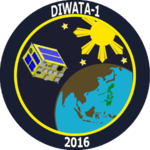 Diwata-1 | |
| Mission type | Earth Observation |
|---|---|
| Operator | DOST (through PEDRO) Tohoku University (through CRESST) |
| COSPAR ID | 1998-067HT |
| SATCAT no. | 41463 |
| Website | http://phl-microsat.upd.edu.ph/ |
| Spacecraft properties | |
| Manufacturer | DOST University of the Philippines Hokkaido University Tohoku University |
| BOL mass | 50 kg (110 lb) |
| Dimensions | 55 x 35 x 55 cm |
| Start of mission | |
| Launch date | 03:05:48, March 23, 2016 (UTC)[2] |
| Rocket | Atlas V 401 |
| Launch site | Cape Canaveral SLC-41 |
| Contractor | United Launch Alliance |
| Deployed from | ISS |
| Deployment date | 11:45:00, April 27, 2016 (UTC)[3] |
| Entered service | 22:33:00, April 27, 2016 (UTC)[1] |
| End of mission | |
| Disposal | Decommissioned; Earth re-entry |
| Deactivated | April 5, 2020 (UTC) |
| Last contact | 08:49:00, April 5, 2020 (UTC) |
| Decay date | 6 April 2020 |
| Orbital parameters | |
| Regime | Low Earth[4] |
| Inclination | 51.6°[5] |
| Mean motion | 4 |
| Velocity | 7,000 m/s (16,000 mph)[4] |
| Instruments | |
| High Precision Telescope (HPT) Space-borne Multispectral Imager (SMI) (with Liquid Crystal Tunable Filter (LCTF)) Wide Field Camera (WFC) Middle Field Camera (MFC) | |
 Diwata-1 mission emblem | |
Diwata-1[6] also known as PHL-Microsat-1 was a Philippine microsatellite launched to the International Space Station (ISS) on March 23, 2016, and was deployed into orbit from the ISS on April 27, 2016. It was the first Philippine microsatellite and the first satellite built and designed by Filipinos.[7][8] It was followed by Diwata-2, launched in 2018.
- ^ Dimacali, TJ (April 28, 2016). "Diwata-1 phones home: 'Maayos ang lahat'" [Diwata-1 phones home: 'Everything's okay']. GMA News. Retrieved April 28, 2016.
- ^ Cite error: The named reference
sfn-launch-schedulewas invoked but never defined (see the help page). - ^ Cite error: The named reference
deployedintospacewas invoked but never defined (see the help page). - ^ a b Suarez, KD (January 13, 2016). "One giant leap: PH microsatellite a step closer to launch". Rappler. Retrieved January 13, 2016.
- ^ Cite error: The named reference
chibameetingwas invoked but never defined (see the help page). - ^ Usman, Edd (January 13, 2016). "PH makes history, hands over Diwata-1 to JAXA for space launch". Manila Bulletin. Archived from the original on January 16, 2016. Retrieved January 13, 2016.
- ^ "First Philippine microsatellite "DIWATA" set to launch". Official Gazette of the Republic of the Philippines. January 18, 2015. Archived from the original on August 31, 2023. Retrieved February 7, 2016.
- ^ Cite error: The named reference
pdisettogowas invoked but never defined (see the help page).